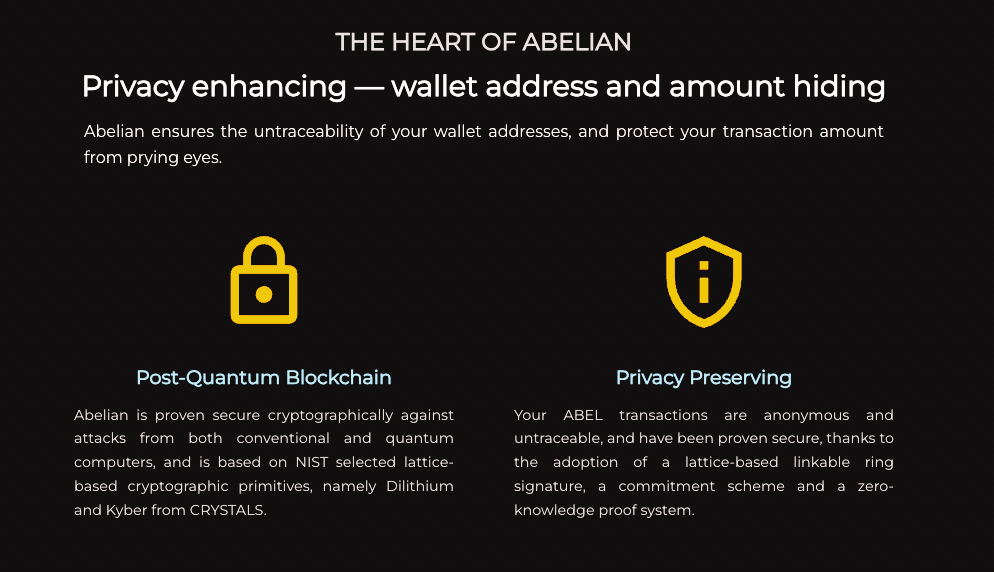Altcoinist Review: $ABEL, Abelian - The Quantum Hedge

"Noah looked like a fool until it started to rain."
- Post-Quantum PoW L1 Blockchain
- 4+ Years of Research:
To achieve Quantum resistant + Privacy supporting cryptographic system - Enhanced Anonymity Tools:
Implements linkable ring signatures and one-time transaction addresses. - Dual-Layered Security:
Combines lattice-based schemes and zero-knowledge proofs for robust protection. - Scalability: GPU-based PoW mining, developing an L2 EVM-equivalent smart contract layer supporting 1,000 transactions per second
"If large-scale quantum computers are ever built, they will be able to break many of the public-key cryptosystems currently in use. This would seriously compromise the confidentiality and integrity of digital communications on the Internet and elsewhere... Therefore, regardless of whether we can estimate the exact time of the arrival of the quantum computing era, we must begin now to prepare our information security systems to be able to resist quantum computing."
With the swift growth and integration of decentralized ledger technology in various business and financial sectors, the importance of developing a blockchain immune to quantum attacks becomes evident.
Scientists from the University of Sussex in the UK estimate that quantum systems with 13 million qubits would be sufficient to break the cryptographic algorithm (elliptic curve-based cryptography) that secures the Bitcoin blockchain within the space of 24 hours.

Tackling this challenge, a team of cryptographers and mathematicians from the Singapore-based Abelian project has pioneered the creation of the world's first L1 post-quantum blockchain. Their development of a unique cryptocurrency complements this groundbreaking effort focused on preserving privacy.
Abelian's Inception and Inspiration: Conceived by Bob, Eve, Lamda, and Alice (ABEL), Abelian was inspired by Bitcoin's role as digital gold and seeks to evolve this concept in the face of quantum threats.
Quantum Computing Threat to Cryptography: Recognizing the vulnerability of Bitcoin and other cryptocurrencies, Abelian identifies the potential of quantum computers to break cryptographic security.
Progression of Quantum Computers:
- 2019: Google and IBM's development of 53-qubit quantum computers.
- 2021: QuEra's construction of a 256-qubit quantum computer.
- 2022: IBM's announcement of a future 1,000-qubit quantum computer.
- PsiQuantum's $215 million funding for a 1,000,000 qubit quantum computer.
Post-Quantum Cryptography (PQC):
America's NIST has been standardizing PQCrypto algorithms for 5 years, with some finalized in July 2022 and the first set of post-quantum algorithms set for official publication in 2024. This global initiative extends beyond blockchain, emphasizing the urgency of quantum-resistant networks.
Peter Shor's Research and NSA Concerns:
Peter Shor's work demonstrated the vulnerability of encryption standards to quantum computing, causing concerns about national security.
Quantum Computing's Broad Industry Impact:
Potential threats extend to finance, healthcare, identity management, IoT, supply chains, and automotive industries.
Post-Quantum Cryptography Necessity:
The advancements in quantum computing underscore the need for quantum-resistant blockchain systems like Abelian.
Abelian Development Challenges:
The primary challenge was designing a cryptographic system that is quantum-resistant and supports privacy. This involved over four years of research and global peer-reviewed publication of the cryptographic systems used in Abelian.
Abelian's Quantum-Resistant Blockchain:
Developed to be immune to quantum computer attacks, featuring:
- Lattice-based linkable ring signature schemes for sender anonymity.
- One-time use of receiver addresses for each transaction.
- Lattice-based commitment scheme and zero-knowledge proof system for transaction privacy.

Abelian's Core Value of Privacy
Recognizes a significant gap in privacy within the crypto space and aims to address it with effective technological solutions.
- Privacy and Security Interconnection: Highlights how privacy and security are closely linked, especially in the context of public ledger cryptocurrencies.
- Public Ledger Vulnerability: Identifies risks in blockchain transparency, such as exposure of wallet addresses and transaction details, increasing susceptibility to hacks and traceability concerns.
- Fundamental Human Right to Privacy: Emphasizes privacy as a key human right and its importance in the Web 3.0 space.
- Challenges with Privacy Coins: Addresses the issues privacy coins face, including their use in illegal transactions and regulatory backlash, impacting the future of privacy in Web 3.0.
- Abelian's Privacy with Accountability Approach: Offers a unique solution balancing user privacy with regulatory compliance through various privacy levels.
- Basic Privacy: Provides pseudonym-based anonymity similar to Bitcoin, enhanced with one-time coin addresses for receiver privacy.
- Full Privacy: Ensures complete anonymity and untraceability with hidden transaction amounts and wallet addresses, using lattice-based cryptographic techniques.
- Full Privacy with Accountability: Allows transaction tracking by authorized users, maintaining full privacy for others, suitable for enterprises and regulatory compliance.
- Commitment to Advancing Encryption Standards: Abelian is dedicated to elevating existing encryption systems, focusing on continuous growth and innovation.
Use Cases and Implementation
Positioned as digital gold in the quantum era, Abelian's secure, robust, and privacy-preserving nature makes it suitable for applications requiring privacy assurance. Its L2 development will make digital assets like NFTs, stablecoins, and DeFi applications quantum-resistant.
Abelian's Post-Quantum Solution:
Leverages lattice-based cryptographic algorithms, aligned with NIST's standards, to combat quantum computing threats.
- Abelian's Vision: To establish a more secure and private blockchain, termed "digital gold 2.0", harnessing the expertise of cryptographers, mathematicians, and computer scientists.
- Goal of a Robust Ecosystem: Aims to build a scalable and secure blockchain ecosystem, providing unparalleled security and privacy in response to quantum risks.
Duncan Wong, Co-founder of Abelian
- Involvement in Abelian: Founding member of the Abelian project, a quantum-safe, privacy-preserving cryptocurrency.
- Previous Leadership in FinTech: Led the Financial Technologies (FinTech) Initiative at Hong Kong's ASTRI, focusing on Cybersecurity, Blockchain, AI, Big Data Analytics, and Machine Learning.
- Academic Tenure: Former professor at the Chinese University of Hong Kong and tenured in the City University of Hong Kong Department of Computer Science.
- Research and Academic Contributions: Authored over 200 papers in Cryptography and Information Security and has been a significant member and chair of program committees for numerous international conferences in the field.
$ABEL Tokenomics
The Mainnet of Abelian Blockchain was launched in March 2022. ABEL is the symbol of the native token of the Abelian Mainnet and is mined during the creation of each block.
Market cap: $52M
Total supply: 225.18 million ABELs or 251-1 Neutrinos, where 1 ABEL = 10,000,000 Neutrinos.
Pre-mined: 20.58 million ABELs in the Genesis Block, which counts towards 9.14% of the total supply. These tokens are for fundraising, community build-up, and marketing.
The rest 204.6 million ABELs (90.86% of the total supply) will all be mined by the community.
- The block frequency is set to 256 seconds.
- 400,000 blocks define each era, and there are altogether 10 eras. Hence the total expected time to mine is 32.5 years.
- In the first era, each block reward was 256 ABELs. That means there will be 102.4 million ABELs created in the first era.
- Halving happens after each era. In the final era, the block reward will be 0.5 ABEL.
- Every 4,000 blocks is one epoch. The POW difficulty is adjusted after each epoch according to the actual computational power of the network in the last epoch.
- Transition from Proof of Work to Proof of Stake for scalability and sustainability.
Partnerships and Collaborations:
Abelian collaborates with research teams from top universities such as Nanyang Technological University, University of Wollongong, and Texas A&M University and works closely with CryptoBLK to build enterprise blockchain systems.
Strategic Partnerships and Network Expansion:
Abelian's partnership with Draper Dragon and the rapid expansion of its mining network and nodes.
Future of Quantum-Resistant Blockchains:
More quantum-resistant blockchains are expected to emerge, with Abelian leading as a privacy-preserving option. In 5-10 years, these blockchains will be essential for industry survival and widespread adoption.
Abelian plans to open-source its code by 2023 for community-driven development.
Altcoinist Verdict
Abelian stands out in the blockchain realm with its innovative, quantum-resistant PoW blockchain backed by extensive research and advanced privacy tools. While there are other projects like $QANX or $CELL aiming to bring post-quantum cryptography into the industry, $ABEL 's combination of lattice-based security, decentralized GPU mining, and scalable smart contract capabilities could position it as a leader in safeguarding against quantum computing threats in the crypto space.
#DYOR


